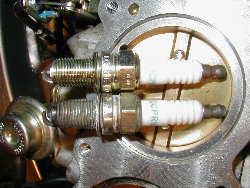
The Falco owners' manual
calls out two acceptable spark plugs. Both are NGK resistors plugs,
standard gap with maybe a slightly extended nose. This is an
inexpensive plug, at about $3 apiece. My bike was shipped with the
colder heat range DCPR9E. You can go safely go up one
heat range to a DCPR8E according to the sticker on the
bike. There are probably plugs made by other manufacturers (Denso,
perhaps) that have the same reach and heat range, but there is
no universal conversion of heat ranges between manufacturers that
works for all engines.
The R in the plug identification means the plug contains a high resistor in order to surpress radio noise. Most likely, the high tension leads feeding the plug are highly resistive too (8kohm a foot typical).

|
Two types of NGK plugs are specified by Aprilia for the Falco. On top is the DCPR8E. Below is the stock DCPR9E. |
A colder plug means that the electrode does not extend as far into the cylinder. The electrode will be more shielded from combustion heat, but more importantly will have less thermal impedance, or will sink more heat back into the cylinder head than a "hotter" plug. The objective is to select a heat range that burns off contaminants at the same rate they are deposited. Too cold a plug will become coated with deposits and will foul. Too hot and the insulator may crack, the electrode edges will round, pre-ignition can occur, or if the plug reaches too far, the plug could actually contact the piston at speed.
Street plugs typically have extended noses like this one, because they must be operated in conditions of low speed or idling without fouling. Service intervals are not as often as a race bike either, so it's helpful that deposits can become greater without fouling the extended nose plug.
Much has been said about "reading" plugs. I guess what you have to remember is that the plug is a history of a lot of running hours, under many different operating conditions and with fuel from different pumps. If the plug is burning hot, it may be dominated by a snapshot of the last operating condition, but if you were running lean for 10,000 miles then pulled the plug after operating the choke for 1 minute, you'd probably never see the lean condition. If you really want to read plugs, you have to start with a fresh plug and operate the bike at the one condition you are interested in. Then kill the motor and coast it to a stop without changing the conditions. An exhaust gas analyzer is much easier to read.
The ignition system in the Falco is mostly likely "inductive", as opposed to CDI, or capacitive discharge. I say this because the plug gap is fairly low, not because I could read the wiring diagram. Some day I will put a scope on it. Each plug is fed by its own coil (four in total). Ken Zeller at Evoluzione Cyclesports makes a device for the Falco which boosts the coil primary voltage to strengthen the spark. It is supposedly a well-tried and failsafe device. I'm not sure if it makes more power, or just makes a more reliable spark.
The Falco manual says to clean and regap the plugs at the 4,650 mile service, then to replace at 9,350 miles. It is a good idea to file the electrode sharp at the first service. A sharp edge will arc over at lower voltages, or will maintain a spark longer. You probably don't want to clean plugs with a wire wheel as I've done in the past. I've read that this can embed conductive particles in the insulator and your plug can short. I also used to work at a shop that had a portable sandblasting tool for cleaning plugs. Even blowing with compressed air afterwards, you were never quite sure if there was a piece of sand still stuck up in the insulator. I usually just replace them if I have new plugs on hand, or file and regap and skip the cleaning step.
Before removing the spark plugs on the Falco, you'll definitely want to blast the head cavities with compressed air. Mine were full of sand. For a description of how to get to the plugs, see the airbox page. When replacing the plugs, you can use the torque figures given below, but this is one of the only places I don't trust a torque wrench. The feel of the gasket crushing has an eerie feeling similar to that of threads stripping. It has to be experienced by hand to be appreciated.
| Summary of Spark Plug Features | |||||||
| NGK plug | Heat range | Operating conditions | Reach | Thread dia | Gap | Socket size | Torque |
| DCPR9E | Colder | Higher speed/higher temperature | 18 mm | 12 mm | 0.024-0.028 in (0.6-0.7 mm | 5/8 in | 14 ft/lbs (20 Nm |
| DCPR8E | Hotter | Lower speed/lower temperature | |||||
Go back to the Falco home page.